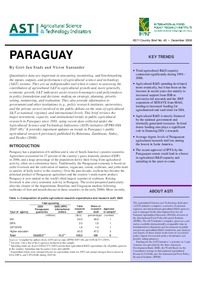Authors:
Stads , Gert-Jan; Santander, Víctor
Year:
2008
Publisher
International Food Policy Research Institute (IFPRI)
Back to:
In 2006, Paraguay employed just 128 fte researchers and spent $13 million (in 2005 PPP prices) on agricultural research. The country compares very unfavorably to its MERCOSUR neighbors when it comes to agricultural research capacity and investments. Paraguay has experienced a steady decline in agricultural researcher totals since the early 1990s; it has one of the lowest shares of agricultural R&D staff with PhD degrees in the world; and its agricultural R&D investments as a share of agricultural GDP are five to seven times lower than those in neighboring Argentina and Brazil.
Many of the weaknesses above can be ascribed to the relatively late establishment of an official S&T structure, a lack of political will to invest in agricultural R&D, and a widespread reliance on technologies generated elsewhere—mainly in Brazil and Argentina. Numerous changes within MAG over the past year have caused various delays in the establishment of IPTA, the long awaited national agricultural research institute. Paraguay is unique among its MERCOSUR neighbors in that it lacks such a national agricultural research institute. This has created a climate in which the higher education sector (mainly UNA) is the strongest component of the national agricultural research system.
Nevertheless, increased IDB support for the development of science, technology, and innovation as well as the Paraguayan government’s recent approval for the creation of IPTA are signs that change may be on the horizon. With the creation of IPTA, agricultural R&D in Paraguay is expected to receive a boost in funding (through various mechanisms), but exactly how much remains a question of speculation. Paraguay currently depends too much for its principal export crops on R&D carried out by
its neighbors. The new IPTA, therefore, has the important role of focusing on research that will increase the value of Paraguay’s agricultural products and thus make Paraguay’s competitive position stronger in a global market.

